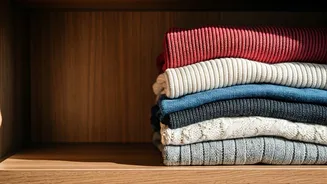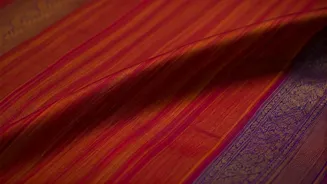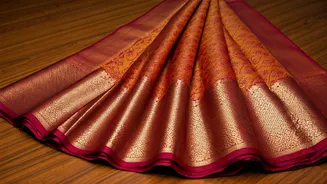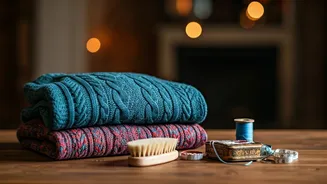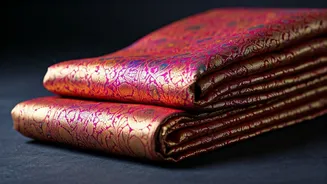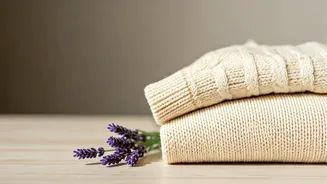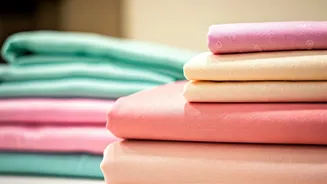Gentle Washing Matters
The method of washing can significantly impact the lifespan of knitwear. Many items are better off being hand-washed to prevent damage caused by aggressive
machine cycles. Use lukewarm water and a mild detergent specifically designed for delicate fabrics. Submerge the knitwear gently, agitate it softly, and avoid excessive rubbing or wringing. Rinse thoroughly to remove all traces of soap. Remember, a gentle approach prevents fibers from stretching, pilling, or losing shape. If machine washing is unavoidable, use a delicate cycle and a mesh laundry bag for added protection. Prioritize hand washing for optimal results, ensuring your favorite knitwear stays in excellent condition.
Drying with Care
Proper drying techniques are crucial for maintaining the integrity of knitwear. Avoid using a machine dryer, as the heat can cause shrinkage, distortion, and fiber damage. Instead, gently roll the wet garment in a clean towel to absorb excess water. Then, lay the knitwear flat on a clean, dry surface, ideally a drying rack or a towel. Reshape the garment while it's still damp to maintain its original form. Ensure proper air circulation around the garment. Avoid direct sunlight or heat sources, as they can cause fading and damage. By drying your knitwear correctly, you prevent stretching and preserve its shape, ensuring it remains wearable and attractive for years to come. Patience and care during the drying process are key to longevity.
Dealing with Stains
Stains can be a major issue, but addressing them promptly and correctly is essential. Act quickly to treat any stains on your knitwear. Identify the stain and use the appropriate method for removal. For instance, dab fresh spills with a clean cloth, avoiding rubbing, which can worsen the stain. For common stains, a gentle stain remover or a mixture of mild detergent and water can work wonders. Always test the solution on an inconspicuous area of the garment first to ensure it doesn't cause discoloration. Rinse thoroughly after treatment and follow the washing instructions. Remember, the sooner you address a stain, the better the chances of removing it without damaging the knitwear fibers. Be patient and persistent to keep your knitwear looking its best.
Effective Storage Solutions
Correct storage is crucial for protecting knitwear from damage and extending its lifespan. Before storing, ensure garments are clean and completely dry. Fold sweaters and other knit items instead of hanging them, as hanging can distort their shape and cause stretching, especially heavier knitwear. Place folded garments on shelves or in drawers to prevent stretching. Use breathable storage containers, such as cotton bags or fabric boxes, to protect the knitwear from dust, moisture, and pests. Avoid storing knitwear in plastic bags, as they can trap moisture and cause mildew. Adding cedar chips or lavender sachets to your storage space can deter moths. Consider the climate in India, where humidity is often high, and take precautions against dampness. Proper storage keeps your knitwear organized and preserves their quality.
Brush and Refresh
Regular maintenance, such as brushing, can help maintain the appearance of your knitwear. Use a soft brush designed specifically for knit fabrics to gently remove lint, fuzz, and pilling. Brush your knitwear after each wear, moving in the direction of the knit to avoid damaging the fibers. This process helps to keep the garment looking fresh and preventing the buildup of unsightly balls of fiber. Additionally, airing out your knitwear between wears can also help keep them refreshed. Simply hang the garment in a well-ventilated area for a few hours. This allows the fibers to relax and any lingering odors to dissipate. By incorporating brushing and airing into your knitwear care routine, you can significantly extend the time your favorite items look their best.
Mend, Don't Discard
Minor damage doesn't always mean the end for your beloved knitwear. Learn basic mending techniques to extend the life of your garments. Small holes or loose threads can often be repaired with a needle and thread. Try to match the yarn color as closely as possible to make repairs nearly invisible. For larger holes or more complex repairs, consider seeking professional help from a tailor or a knitting specialist. Addressing problems quickly prevents further damage and keeps your knitwear wearable. Embrace the concept of mending to reduce waste and appreciate the enduring value of your clothes. Repairing rather than discarding damaged items reflects a mindful approach to fashion and sustainability, a mindset increasingly relevant in modern India.
Steaming Over Washing
For knitwear that needs refreshing but doesn't require a full wash, steaming is a good alternative. Steaming can help remove wrinkles, freshen the garment, and eliminate odors without exposing it to the stress of washing. Use a handheld steamer or the steam function on your iron, holding the steamer a few inches away from the fabric. Move the steamer gently over the garment, allowing the steam to penetrate the fibers and relax them. Avoid touching the steamer directly to the knitwear to prevent damage. Steaming is particularly useful for delicate knitwear that may be easily damaged by washing. By incorporating steaming into your care routine, you can keep your knitwear looking great between washes. It's a quick and efficient way to maintain freshness.
Protect From Moths
Moths can be a significant threat to knitwear, so it’s important to take preventative measures. Always store clean garments, as moths are attracted to food stains and body oils. Use cedar blocks or lavender sachets in your storage areas. These natural repellents deter moths and protect your knitwear. Regularly inspect your knitwear, especially during seasonal changes, for signs of moth activity, such as small holes or webbing. If you find any, take immediate action to address the infestation. You can either freeze the garment to kill any eggs or larvae or have them professionally treated. By taking proactive steps against moths, you can protect your investment and extend the life of your knitwear for years to come.
Keep Them Fresh
Maintaining freshness helps your knitwear look and feel better. After wearing knitwear, especially in humid conditions, air them out. Hang the garment in a well-ventilated area, away from direct sunlight, to allow any odors to dissipate. Avoid wearing the same knitwear item multiple days in a row; give it time to recover and refresh. Occasionally, you can also use fabric refreshers that are specifically designed for delicate materials. However, always test it on an inconspicuous area first. Using a laundry detergent with a pleasant but gentle scent during washing also helps, contributing to the overall freshness of your knitwear. Simple practices like these will keep your garments pleasant and ready to wear.
The Right Way to Store
Proper storage is the final key to ensuring the longevity and good condition of your knitwear. Always ensure knitwear is completely dry before storing it. Fold knitwear neatly rather than hanging it, unless it's a very sturdy piece. Place folded items in drawers, shelves, or storage boxes. Use breathable storage containers. Avoid plastic bags, as they trap moisture. Consider using cedar blocks, lavender sachets, or mothballs to protect from moths. If you are storing knitwear for a long period, consider storing it in a vacuum-sealed bag to protect from dust, moisture, and pests. By adhering to the above, your knitwear will be ready to wear when you need them.
